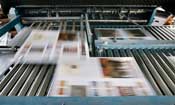 You might think that a discussion about folding machine productivity could never be heated. Think again! In our experience, the subject of folder speed versus productivity was divisive, causing lengthy discussions and loud disagreements among folder operators and shop management.
You might think that a discussion about folding machine productivity could never be heated. Think again! In our experience, the subject of folder speed versus productivity was divisive, causing lengthy discussions and loud disagreements among folder operators and shop management.
Since man began putting ink on paper, one of the driving-force questions has always been “How can we do this faster?” Answers to that question have led to remarkable new technologies in printing and bindery equipment and there is always something faster and better on the horizon.
The big disagreement would arise however, over how to get the maximum productivity from the varied bindery equipment at hand. The "experienced" operators steadfastly insisted, to the point of becoming red-faced, that you simply had to crank up the speed control and run the machine as fast as it would possibly run. It didn’t matter if you had to stop frequently for reloading or for clearing paper jams.
In our opinion, the appropriate argument would be that if you ran the machine at the maximum non-stop speed possible, the yield at the end of the shift would be greater than their crank-it-up-to-10 effort. If for example, you were to run the folder at 4000 sheets an hour without having to stop to reload, to catch up on the delivery, to make adjustments, then you would get more done than the guy who turned the machine up to 6000 sheets an hour but had to stop every few minutes to take care of something. They were confusing machine speed with productivity.
Kevin Carey writes in his ABC’s of Diemaking & Diecutting, “almost anyone can run a press [or folding machine in our case] at its slowest speed, but far fewer can run the press at its maximum speed. Increasing speed exposes weaknesses in methods, in practices, in tools, in technology, in organization, and in knowledge, skill and experience.”
Notice there are at least 8 variables mentioned that directly affect the speed at which any given operator can run a machine. In other words, running at a maximum speed will expose any and every flaw in operator, machine and work methods, to the point it will have a negative impact on productivity.
So Which Theory Is Right?
The only way to resolve such disagreement is of course to see who produces the most per shift over a period of time. This particular printing company referenced had an IT guy who could track how many breaths each employee took in a day, number of sheets folded, number of sheets wasted and most importantly, the average daily production for any given time frame. It was impressive, considering he did this back in the pre-personal computer days of punch cards.
The result: It was a hard lesson for the old-timers at the company who believed they were running their machines ‘faster.’ Their average daily production was substantially lower, month after month. It didn't matter whether it was the brand new MBO folder or an old Dexter. Maximum non-stop speed was the better strategy for maximum yield on any given machine.
The challenge of course is that such an effort requires personal responsibility. It would be easy for a lazy operator to loaf along at what he claims is his maximum non-stop speed. Even a diligent, responsible operator could, as Carey says, “find a comfort zone or a sweet spot and prematurely settle into that mode.”
In our relentless quest for faster speed which truly yields greater productivity, the question for you is two-fold: how fast are you, (you do know, don’t you?) and what are you doing about becoming faster? That question along with your daily answer, will keep you moving in the right direction.
As always, feel free to share your comments and experience below!

